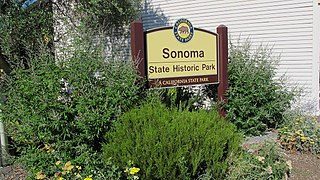Related Research Articles

The California Republic, or Bear Flag Republic, was an unrecognized breakaway state from Mexico, that for 25 days in 1846 militarily controlled an area north of San Francisco, in and around what is now Sonoma County in California.

Don Mariano Guadalupe Vallejo was a Californio general, statesman, and public figure. He was born a subject of Spain, performed his military duties as an officer of the Republic of Mexico, and shaped the transition of Alta California from a territory of Mexico to the U.S. state of California. He served in the first session of the California State Senate. The city of Vallejo, California, is named after him, and the nearby city of Benicia is named after his wife.

The Presidio of Monterey (POM), located in Monterey, California, is an active US Army installation with historic ties to the Spanish colonial era. Currently, it is the home of the Defense Language Institute Foreign Language Center (DLI-FLC). It is the last and only presidio in California to have an active military installation.

Californio is a term used to designate a Hispanic Californian, especially those descended from Spanish and Mexican settlers of the 17th through 19th centuries. California's Spanish-speaking community has resided there since 1683 and is made up of varying Spanish and Mexican origins, including criollos, Mestizos, Indigenous Californian peoples, and small numbers of Mulatos. Alongside the Tejanos of Texas and Neomexicanos of New Mexico and Colorado, Californios are part of the larger Spanish-American/Mexican-American/Hispano community of the United States, which has inhabited the American Southwest and the West Coast since the 16th century. Some may also identify as Chicanos, a term that came about in the 1960s.

The Benicia Arsenal (1851–1964) and Benicia Barracks (1852–66) were part of a large military reservation located next to Suisun Bay in Benicia, California. For over 100 years, the arsenal was the primary US Army Ordnance facility for the West Coast of the United States.
The Department of the Pacific or Pacific Department was a major command (Department) of the United States Army from 1853 to 1858. It replaced the Pacific Division, and was itself replaced by the Department of California and the Department of Oregon.

California's involvement in the American Civil War included sending gold east to support the war effort, recruiting volunteer combat units to replace regular U.S. Army units sent east, in the area west of the Rocky Mountains, maintaining and building numerous camps and fortifications, suppressing secessionist activity and securing the New Mexico Territory against the Confederacy. The State of California did not send its units east, but many citizens traveled east and joined the Union Army there, some of whom became famous.

Fort Mason, in San Francisco, California originated as a coastal defense site during the American Civil War. The nucleus of the property was owned by John C. Frémont and disputes over compensation by the United States continued into 1968. In 1882 the defenses were named for Richard Barnes Mason, a military governor before statehood. Fort Mason became the headquarters for an Army command that included California and the Hawaiian Islands from 1904 to 1907. In 1912 the Army began building a port facility with piers and warehouses to be a home base for ships of the Army Transport Service serving Alaska, Hawaii, the Philippines and other Pacific Army posts and focus of Army supply for the Pacific.

Fort Yuma was a fort in California located in Imperial County, across the Colorado River from Yuma, Arizona. It was on the Butterfield Overland Mail route from 1858 until 1861 and was abandoned May 16, 1883, and transferred to the Department of the Interior. The Fort Yuma Indian School and the Saint Thomas Yuma Indian Mission now occupy the site. It is one of the "associated sites" listed as Yuma Crossing and Associated Sites on the National Register of Historic Places in the Yuma Crossing National Heritage Area. In addition, it is registered as California Historical Landmark #806.

Sonoma State Historic Park is a California State Park located in the center of Sonoma, California. The park consists of six sites: the Mission San Francisco Solano, the Sonoma Barracks, the Blue Wing Inn, La Casa Grande, Lachryma Montis, and the Toscano Hotel.
Rancho Vallecitos de San Marcos was a 8,975-acre (36.32 km2) Mexican land grant in present-day northern San Diego County, California given in 1840 by Governor Juan Alvarado to Jose María Alvarado. The name means little valleys of St. Mark. The grant was located between Rancho Rincon del Diablo of Alvardo's father, Juan Bautista Alvarado on the east and Rancho Buena Vista on the west, and encompassed present day San Marcos.
During the American Civil War, Army reorganization created the Department of the Pacific on January 15, 1861. On December 12, 1861, the District of Humboldt was created, consisting of the counties of Sonoma, Napa, Mendocino, Trinity, Humboldt, Klamath, and Del Norte in Northern California. The district was headquartered at Fort Humboldt, located on a bluff above the central portion of Humboldt Bay south of Eureka, California, which is now a California State Historic Park located within the City of Eureka. The District's efforts were directed at prosecuting the ongoing Bald Hills War against the Indians in the northern, coastal area of the large district. A peace was achieved in August 1864.

The District of Southern California was a 19th century district of Department of the Pacific, a command of the United States Army.
The District of California was a Union Army command department formed during the American Civil War. The district was part of the Department of the Pacific, the commander of the department also being District commander. The district was created as a separate command on July 1, 1864, after Irvin McDowell took command of the Department of the Pacific, relieving General Wright, who then remained as District of California commander. The District comprised the state of California and the areas of the Rogue River and Umpqua River in Southern Oregon. Its headquarters were in San Francisco, co-located with those of the Department of the Pacific. On March 14, 1865, the District of Oregon was extended to include the entire state of Oregon, removing the Rogue River and Umpqua River areas from the District.
Rancho Valle de San Felipe was a 9,972-acre (40.36 km2) Mexican land grant in present-day San Diego County, California given in 1846 by Governor Pío Pico to Felipe Castillo. The grant was located in the San Felipe Valley in the Laguna Mountains east of present-day Julian.

The Department of California was an administrative department of the United States Army. The Department was created in 1858, replacing the original Department of the Pacific, and it was ended by the reorganizations of the Henry L. Stimson Plan implemented in February 1913. As with the preceding organization, headquarters were in San Francisco. Its creation was authorized by General Orders, No. 10, of the War Department, Adjutant-General's Office, September 13, 1858.

Henry Stanton Burton (1818–1869) was a graduate of West Point, a career American Army officer who served in the Second Seminole War, Mexican–American War and the American Civil War.

Vallecito, in San Diego County, California, is an oasis of cienegas and salt grass along Vallecito Creek and a former Kumeyaay settlement on the edge of the Colorado Desert in the Vallecito Valley. Its Spanish name is translated as "little valley". Vallecito was located at the apex of the gap in the Carrizo Badlands created by Carrizo Creek and its wash in its lower reach, to which Vallecito Creek is a tributary. The springs of Vallecito, like many in the vicinity, are a product of the faults that run along the base of the Peninsular Ranges to the west.

The Sonoma Barracks is a two-story, wide-balconied, adobe building facing the central plaza of the City of Sonoma, California. It was built by order of Mariano Guadalupe Vallejo to house the Mexican soldiers that had been transferred from the Presidio of San Francisco in 1835. The Presidio Company and their commander, Vallejo, were also responsible for controlling the Native Americans living on the northern border of Mexican California.

Camp Salvation was a refugee camp set up on September 23, 1849, to help those traveling to the California Gold Rush. Emigrants were crossing the harsh Sonoran Desert to get to California through the Southern Emigrant Trail. The camp was located in the current town of Calexico, California. Lieutenant Cave Johnson Couts, an Escort Commander with the International Boundary Commission set up the camp. From September 23 till December 1, 1849, the camp helped travelers on the trail. In June 1849 the United States Boundary Commission arrived in San Diego to survey the international border between United States and Mexico.
References
- ↑ "393.2 RECORDS OF DIVISIONS 1837-1907 & 1911-13". Records of United States Army Continental Commands 1821-1920. National Archives. Retrieved 1 January 2020.
- ↑ Durwood Ball, Army Regulars on the Western Frontier, 1848–1861, University of Oklahoma Press, Norman, 2001.
- ↑ The California State Military Museum; Historic California Posts: Historic California Posts: Posts at Monterey
- ↑ The California State Military Museum; Historic California Posts: Sonoma Barracks (Including El Presidio de Sonoma, El Cuartel de Sonoma, Camp Sonoma, Sonoma Post)
- ↑ The California State Military Museum; Historic California Posts: Camp San Jose
- ↑ The California State Military Museum; Historic California Posts: Camp Anderson, (Post near Sacramento City, Post near Sutterville)
- ↑ The California State Military Museum; Historic California Posts: Camp Stanislaus (Miller's Camp)
- ↑ The California State Military Museum; Historic California Posts: Camp Riley
- ↑ Camp Salvation, California State Historic Landmark 808
- ↑ The California State Military Museum; Historic California Posts: Camp San Miguel
- ↑ The California State Military Museum; Historic California Posts: Cantonment Far West (Camp Far West, Fort Far West)
- ↑ The California State Military Museum; Historic California Posts: Fort McDowell(Camp Reynolds, Post of Angel Island)
- ↑ The California State Military Museum; Historic California Posts: Rancho del Chino Post
- ↑ The California State Military Museum; Historic California Posts: Post at Mission San Luis Rey de Francia (Camp San Luis Rey)
- ↑ The California State Military Museum; Historic California Posts: Camp Frederica
- ↑ The California State Military Museum; Historic California Posts: Camp Vallecito
- ↑ The California State Military Museum; Historic California Posts: Fort Defiance(Imperial County)
- ↑ The California State Military Museum; Historic California Posts: Camp Santa Isabel (Camp Santa Ysabel)
- ↑ The California State Military Museum; Historic California Posts: Camp McClear
- ↑ The California State Military Museum; Historic California Posts: San Diego Barracks(Including New San Diego Depot)
- ↑ The California State Military Museum; Historic Posts, Camps, Stations and Airfields: Fort Miller (Including Camp Barbour, Camp Miller)
- ↑ The California State Military Museum; Historic California Posts: Historic California Posts: Camp Crane
- ↑ The California State Military Museum; Historic California Posts: Camp Fitzgerald (Imperial County)
- ↑ The California State Military Museum; Historic California Posts: Camp Rancho del Jurupa
- ↑ The California State Military Museum; Historic California Posts:Fort Reading
- ↑ Fort Reading, California State Historic Landmark 379
- ↑ The California State Military Museum; Historic California Posts: Fort Jones (Siskiyou County)
- ↑ "393.2 RECORDS OF DIVISIONS 1837-1907 & 1911-13". Records of United States Army Continental Commands 1821-1920. National Archives. Retrieved 1 January 2020.
- ↑ "393.2 RECORDS OF DIVISIONS 1837-1907 & 1911-13". Records of United States Army Continental Commands 1821-1920. National Archives. Retrieved 1 January 2020.
- ↑ "393.2 RECORDS OF DIVISIONS 1837-1907 & 1911-13". Records of United States Army Continental Commands 1821-1920. National Archives. Retrieved 1 January 2020.
- ↑ James, D. Clayton (1 October 1970). The Years of MacArthur Volume 1 1880-1941 (1st ed.). Boston, Massachusetts: Houghton Mifflin Company. p. 43. ISBN 978-0395109489 . Retrieved 1 January 2020.
- ↑ James, D. Clayton (1 October 1970). The Years of MacArthur Volume 1 1880-1941 (1st ed.). Boston, Massachusetts: Houghton Mifflin Company. p. 42. ISBN 978-0395109489 . Retrieved 1 January 2020.
- ↑ James, D. Clayton (1 October 1970). The Years of MacArthur Volume 1 1880-1941 (1st ed.). Boston, Massachusetts: Houghton Mifflin Company. p. 42,87. ISBN 978-0395109489 . Retrieved 1 January 2020.